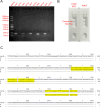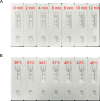Development and application of a rapid visual detection technique for VanA gene in vancomycin-resistant Enterococcus faecium
- PMID: 39254311
- PMCID: PMC11520281
- DOI: 10.1128/msphere.00666-24
Development and application of a rapid visual detection technique for VanA gene in vancomycin-resistant Enterococcus faecium
Abstract
The objective of this study was to establish a rapid visual diagnosis method for vancomycin-resistant Enterococcus faecium (VREFm) based on multienzyme isothermal rapid amplification (MIRA) combined with lateral flow strips (LFSs). The MIRA primers and probes were specifically designed to maintain the sequence of the VanA gene of VREFm. We optimized the reaction time and temperature and thoroughly assessed the specificity and sensitivity of the MIRA-LFS system. We also compared the MIRA-LFS method with the polymerase chain reaction (PCR) assay and the disc diffusion method. We then evaluated the MIRA-LFS assay for consistency testing and clinical application. The MIRA-LFS technique completed the amplification process within 30 min, and the results were observed on LFS. The method demonstrated high sensitivity, with a minimum detection limit of 1.066 CFU/µL for VREFm and exhibited specificity without cross-reactivity with other pathogenic bacteria. When applied to the detection of clinical samples, the method exhibited consistency with the PCR and agar dilution methods. The combined use of MIRA and LFS in this study facilitates simplifying the workflow for detecting VREFm, which is of great significance for rapidly detecting the enterococcal infections and preventing and controlling the nosocomial infections.
Importance: One of the key approaches to treating and controlling vancomycin-resistant Enterococcus faecium (VREFm) is an accurate and rapid diagnosis. To achieve this goal, a simple and rapid method must be constructed for immediate detection in the field. Multienzyme isothermal rapid amplification (MIRA) is an isothermal rapid amplification method that allows amplification reactions to be completed under room temperature conditions. When combined with lateral flow strips (LFSs), MIRA-LFS enables the rapid detection of pathogenic microorganisms. However, the MIRA method often produces false signals. These false signals are eliminated by using base mismatches introduced in primers and probes. The MIRA-LFS system was constructed with high specificity and sensitivity for the detection of VREfm, without the limitation of sophisticated instruments. This enables the prompt formulation of diagnostic and therapeutic decisions.
Keywords: Enterococcus faecium; lateral flow strips; multienzyme isothermal rapid amplification; vancomycin-resistant.
Conflict of interest statement
The authors declare no conflict of interest.
Figures





Similar articles
-
Development of a strain-specific PCR as a diagnostic tool for surveillance, detection, and monitoring of vancomycin-resistant Enterococcus faecium during outbreak.Antimicrob Resist Infect Control. 2025 Mar 24;14(1):23. doi: 10.1186/s13756-025-01538-1. Antimicrob Resist Infect Control. 2025. PMID: 40128808 Free PMC article.
-
Prevalence of Diverse Clones of Vancomycin-Resistant Enterococcus faecium ST78 in a Chinese Hospital.Microb Drug Resist. 2016 Jun;22(4):294-300. doi: 10.1089/mdr.2015.0069. Epub 2015 Dec 10. Microb Drug Resist. 2016. PMID: 26652286
-
High prevalence of the recently identified clonal lineage ST1299/CT3109 vanA among vancomycin-resistant Enterococcus faecium strains isolated from municipal wastewater.mSphere. 2024 Sep 25;9(9):e0039624. doi: 10.1128/msphere.00396-24. Epub 2024 Aug 27. mSphere. 2024. PMID: 39189779 Free PMC article.
-
A molecular study regarding the spread of vanA vancomycin-resistant Enterococcus faecium in a tertiary hospital in China.J Glob Antimicrob Resist. 2022 Dec;31:270-278. doi: 10.1016/j.jgar.2022.10.010. Epub 2022 Oct 20. J Glob Antimicrob Resist. 2022. PMID: 36273808 Review.
-
Thirty years of VRE in Germany - "expect the unexpected": The view from the National Reference Centre for Staphylococci and Enterococci.Drug Resist Updat. 2020 Dec;53:100732. doi: 10.1016/j.drup.2020.100732. Epub 2020 Oct 27. Drug Resist Updat. 2020. PMID: 33189998 Review.
Cited by
-
Application of matrix-assisted laser desorption ionization time-of-flight mass spectrometry in the detection of vancomycin-resistant and-susceptible Enterococcus faecium.Front Microbiol. 2025 Jun 6;16:1603986. doi: 10.3389/fmicb.2025.1603986. eCollection 2025. Front Microbiol. 2025. PMID: 40547796 Free PMC article.
References
MeSH terms
Substances
Supplementary concepts
LinkOut - more resources
Full Text Sources
Molecular Biology Databases
